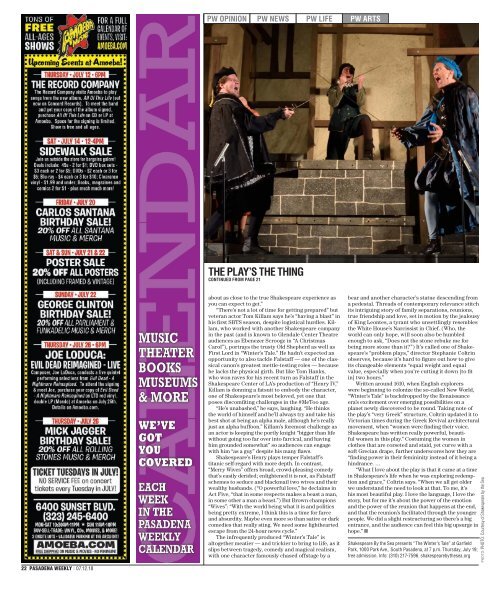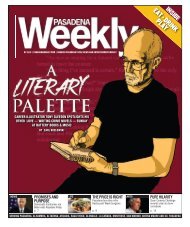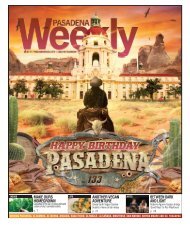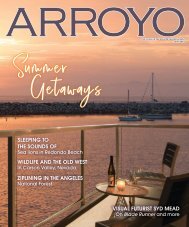07.12.18
Create successful ePaper yourself
Turn your PDF publications into a flip-book with our unique Google optimized e-Paper software.
PW OPINION PW NEWS PW LIFE PW ARTS<br />
THE PLAY’S THE THING<br />
CONTINUED FROM PAGE 21<br />
22 PASADENA WEEKLY | <strong>07.12.18</strong><br />
about as close to the true Shakespeare experience as<br />
you can expect to get.”<br />
“There’s not a lot of time for getting prepared” but<br />
veteran actor Tom Killam says he’s “having a blast” in<br />
his first SBTS season, despite logistical hurdles. Killam,<br />
who worked with another Shakespeare company<br />
in the past (and is known to Glendale Center Theatre<br />
audiences as Ebenezer Scrooge in “A Christmas<br />
Carol”), portrays the trusty Old Shepherd as well as<br />
First Lord in “Winter’s Tale.” He hadn’t expected an<br />
opportunity to also tackle Falstaff — one of the classical<br />
canon’s greatest mettle-testing roles — because<br />
he lacks the physical girth. But like Tom Hanks,<br />
who won raves for his recent turn as Falstaff in the<br />
Shakespeare Center of LA’s production of “Henry IV,”<br />
Killam is donning a fatsuit to embody the character,<br />
one of Shakespeare’s most beloved, yet one that<br />
poses discomfiting challenges in the #MeToo age.<br />
“He’s unabashed,” he says, laughing. “He thinks<br />
the world of himself and he’ll always try and take his<br />
best shot at being an alpha male, although he’s really<br />
just an alpha buffoon.” Killam’s foremost challenge as<br />
an actor is keeping the portly knight “bigger than life<br />
without going too far over into farcical, and having<br />
him grounded somewhat” so audiences can engage<br />
with him “as a guy” despite his many flaws.<br />
Shakespeare’s Henry plays temper Falstaff’s<br />
titanic self-regard with more depth. In contrast,<br />
“Merry Wives” offers broad, crowd-pleasing comedy<br />
that’s easily derided; enlightened it is not, as Falstaff<br />
schemes to seduce and blackmail two wives and their<br />
wealthy husbands. (“O powerful love,” he declaims in<br />
Act Five, “that in some respects makes a beast a man,<br />
in some other a man a beast.”) But Brown champions<br />
“Wives”: “With the world being what it is and politics<br />
being pretty extreme, I think this is a time for farce<br />
and absurdity. Maybe even more so than satire or dark<br />
comedies that really sting. We need some lighthearted<br />
escape from the 24-hour news cycle.”<br />
The infrequently produced “Winter’s Tale” is<br />
altogether meatier — and trickier to bring to life, as it<br />
slips between tragedy, comedy and magical realism,<br />
with one character famously chased offstage by a<br />
bear and another character’s statue descending from<br />
a pedestal. Threads of contemporary relevance stitch<br />
its intriguing story of family separations, reunions,<br />
true friendship and love, set in motion by the jealousy<br />
of King Leontes, a tyrant who unsettlingly resembles<br />
the White House’s Narcissist in Chief. (Who, the<br />
world can only hope, will soon also be humbled<br />
enough to ask, “Does not the stone rebuke me for<br />
being more stone than it?”) It’s called one of Shakespeare’s<br />
“problem plays,” director Stephanie Coltrin<br />
observes, because it’s hard to figure out how to give<br />
its changeable elements “equal weight and equal<br />
value, especially when you’re cutting it down [to fit<br />
in] two hours.”<br />
Written around 1610, when English explorers<br />
were beginning to colonize the so-called New World,<br />
“Winter’s Tale” is backdropped by the Renaissance<br />
era’s excitement over emerging possibilities on a<br />
planet newly discovered to be round. Taking note of<br />
the play’s “very Greek” structure, Coltrin updated it to<br />
Victorian times during the Greek Revival architectural<br />
movement, when “women were finding their voice.<br />
Shakespeare has written really powerful, beautiful<br />
women in this play.” Costuming the women in<br />
clothes that are corseted and staid, yet curve with a<br />
soft Grecian drape, further underscores how they are<br />
“finding power in their femininity instead of it being a<br />
hindrance. …<br />
“What I love about the play is that it came at a time<br />
in Shakespeare’s life when he was exploring redemption<br />
and grace,” Coltrin says. “When we all get older<br />
we understand the need to look at that. To me, it’s<br />
his most beautiful play. I love the language, I love the<br />
story, but for me it’s about the power of the emotion<br />
and the power of the reunion that happens at the end,<br />
and that the reunion’s facilitated through the younger<br />
people. We did a slight restructuring so there’s a big<br />
entrance, and the audience can feel this big upsurge in<br />
hope.” n<br />
Shakespeare By the Sea presents “The Winter’s Tale” at Garfield<br />
Park, 1000 Park Ave., South Pasadena, at 7 p.m. Thursday, July 19;<br />
free admission. Info: (310) 217-7596. shakespearebythesea.org<br />
PHOTO: PHOTO: Courtesy of Shakespeare by the Sea

















